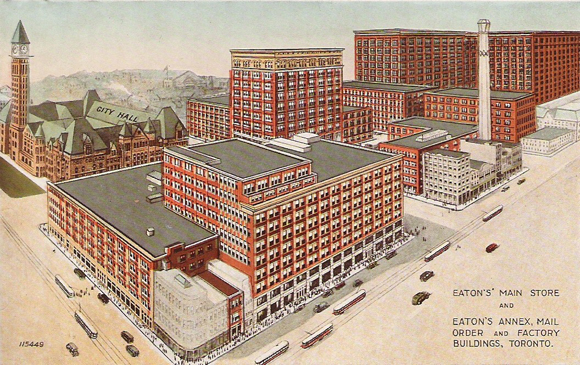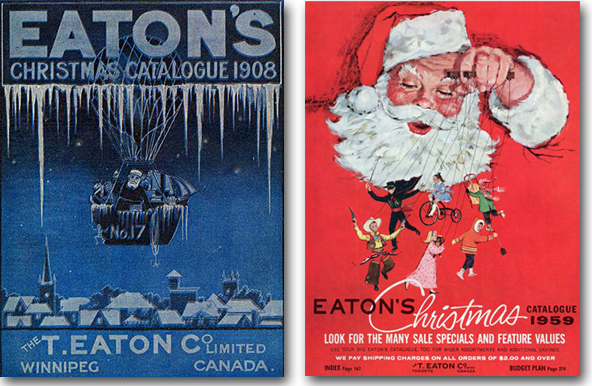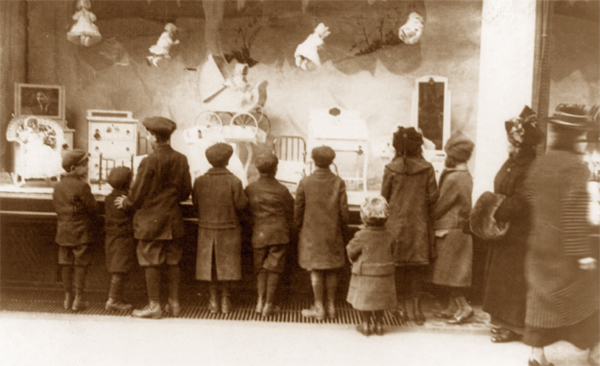
Eaton’s Christmas – 1922
Sometimes in reviewing notes taken from conversations with my aunt, I am struck by just how different her 20-something life in the 1920s was from mine in the 1980s. Sometimes I am struck by how similar it was. One of her Christmas experiences in 1922 was almost identical to mine in 1984. After completing our first term at Victoria College, we both worked as seasonal sales staff at large department stores: in her case Eaton’s; in mine Simpsons.
Each of us would have served customers drawn to the retail emporiums by catalogues, festively decorated store windows, and a parade. Yes, these institutions with which we are all so familiar had all been established by 1922. Let me tell you more.
History
The Eaton’s department store was founded in 1869 by Timothy Eaton, a man of Irish birth. His first store in Toronto was located at 178 Yonge Street. The small store only 24 by 60 feet (7.3 m × 18.3 m) with a staff of four, sold dry and other haberdashery goods. The prospects for the store’s success, being located east of the more fashionable shopping district, and having a no-credit and no haggling policy, were not great.
But prosper, the business did. In 1883, it was moved a block north to 190 Yonge Street, on the west side of Yonge Street, north of Queen. With three full floors of retail space illuminated by eclectic lights (a first in a Canadian store), the business housed 35 departments. By 1885, it had a telephone and a year later, an elevator.
The business continued to grow. In 1911, it employed 17,500 people. In 1919, its Toronto operations occupied over 60 acres of floor space. Flagship stores were opened in Winnipeg in 1905 and Montreal in 1927. When the business went into bankruptcy proceedings in 1999, it had 37 stores in Canada including the nine storey anchor store in the Toronto Eaton Centre, which opened in 1977. At its zenith the business employed over 70,000 people.

Today’s on-line shoppers will not be surprised by the early success of the Eaton’s catalogue. The first Eaton’s catalogue--a mere 34 pages--was issued in 1884, three years after the Hudson’s Bay Company produced its maiden edition and nine years before Simpsons followed suit. The first editions contained only text but three years later the catalogue contained drawn pictures. Coloured pictures followed in 1915. By 1920, the catalogue contained photographs.
In the 1880s Canada’s population was based mostly in small or rural communities. Catalogues, like those of Eaton’s, allowed Canadians in those communities to purchase the same products at the same prices as those living in larger cities. By 1896, Eaton’s was filling 200,000 orders annually— from clothing to farm implements; and even kits for building houses. Orders were often filled with goods manufactured by or for Eaton’s. To support the mail orders, by 1920 Eaton’s had warehouses (i.e. fulfillment centres) in Toronto, Winnipeg and Moncton.
It must be said that Eaton’s success was to the detriment of many small local retailers. However, as we will see (and as my mother often says), what goes around, comes around.
The first Christmas catalogue was produced in 1897. I expect that Jessie and her friends, looked forward to its arrival each Christmas season. It wasn’t known officially as the “wish book”. That name was reserved for the Christmas catalogue produced by Simpsons–Sears, the entity that acquired the catalogue division of Simpsons in 1952.

By the 1970’s with Canada’s population being less rural and with the proliferation of malls, 60% of Canadians lived within a 30 minute drive of an Eaton’s store. For this and other reasons, the catalogue business became less profitable. The 1976 spring summer edition was the last Eaton’s catalogue published.
The Parade
The modern Toronto Santa Claus parade, at a mile and a half in length and with more than 24 floats, 24 bands, and 1,700 participants, is one of the longest in the world. It was not always thus. When the tradition of escorting Santa Claus to the Yonge Street Eaton’s store and thence to Toyland within it, first began in 1905, the jolly old man was led there on foot, with only Mr. and Mrs. Timothy Eaton accompanying him. Three years later, a truck and a band were added to the procession.
By the 1920s the parade was well established. The dramatization of Santa’s journey from the North Pole to Toronto was broadcast on CFRB radio station for a full month, a tradition that continued until the 1950s. Eventually, the parade was televised and viewed across Canada and the United States. Film versions were shown in theatres around the world.
The parade was not a mere buffet of volunteer creativity. The magnificent floats and costumes were all made by Eaton’s. Children had to apply to participate in it. All costs were born by Eaton’s, appropriate perhaps, given the promotion the parade provided to that store. (Certainly, I grew up thinking that the only real Santa Claus was the one in the Eaton’s department store.)
Similar Eaton’s parades were held as well in Winnipeg and Montreal. The Winnipeg parade began in 1909 and continued under the purview of Eaton’s until 1965. Unable to continue to make the financial investments required by it, Eaton’s sold the rights to the parade to the Winnipeg Firefighters Club for a nominal amount. It continues to be operated on a non-profit community basis. The Eaton’s parade ran in Montreal from 1925 until the FLQ crisis in 1969.
The Toronto tradition came to an end in 1982. The troubled Eaton’s empire could not afford to continue it. A non-profit organization assumed responsibility for that parade as well. Due to COIVD -19, the Toronto parade will be operated as a “broadcast only event” this year, airing on CTV on December 4 at 7 p.m. With a number of guest performers in addition to the traditional floats and marching bands, it looks like a great event; one that could not have been broadcast in 1922!

The Windows
Although the Eaton’s and Simpsons department stores took the decoration of store windows at Christmas time to a true art form, the notion of decorating windows as a means to promote purchases from within was hardly new. Window-shopping was a past-time in England since the earliest days of the industrial revolution. The effectiveness of the exercise for both the shoppers and the retailers improved in the 1800s with the illumination of windows, made possible by gas lighting.
Trade publications in the late 1800s urged retailers to adopt displays of Christmas trees surrounded by gifts, and to create images of nursery rhymes and Biblical scenes. But the big department stores sought to create extravagant Christmas windows on an entirely different level. The quest came to the fore in England in 1851 when Fortnum & Mason recreated its award winning Great Exhibition display in its windows – “a tri- cornucopia from which spilled the fruits of the earth”. (A scene which to my mind continues to dominate its windows and internal glass cases). Nine years later, manufactured shooting stars leapt across the Fortnum & Mason windows.

The Macy department store began the magical Christmas window tradition among North American department stores. In 1874, it displayed $10,000-worth of dolls included those at a dolls’ croquet party.
By the 1920s, a visit to the Eaton’s and Simpsons windows in downtown Toronto was a must for children and parents alike. In its December 14, 1926 issue, the Globe described the phenomenon as follows:
There is a peculiar fascination in Christmas window-shopping, and for the lucky beggar whose purse is at once portly and elastic there is a stimulus in a leisurely stroll along main thoroughfares gazing upon the wonder display flaunted through polished glass plate. On a pre-Christmas afternoon—the purple twilight shattered with shafts of rosy light gleaming from a thousand meteor-lights illuminating the shopping district of the city—men and women, boys and girls loitered in the glare, finding appeal in the magnificence of the Yuletide exhibit.
As was the case with the parade floats, wherever possible Eaton’s made the props within its windows including the mechanical aspects which allowed for movement of their model trains, toys, animals and people. Doing so was a year round job for staff within the Merchandise Display Department both at Eaton's Sheppard and Highway 400 service building and in the case of Merchandise Display Manager Ted Konkle and his wife Eleanor, in their home.
The attention on the spectacular windows—their presentations of animated nativity scenes and Santa’s workshop --was likely at its height in the 1950s and 1960s although in 1945, Eaton’s was asked by the city to limit the hours its windows could be viewed (curtains could be drawn across them as they were on Sundays). Traffic was being impeded by the number of shoppers viewing the windows of Eaton’s and its rival, Simpsons.
The development of the Eaton’s Centre in 1977 and the loss of most street level windows brought an end to the Eaton’s Christmas window tradition. The same fate befell the Simpsons windows at its Yonge and Queen Street store when it was purchased by the Hudson’s Bay Company in 1979, but the tradition has since returned.
In a time when so many of our traditions have been altered to suit pandemic requirements, it is heartening to think that the wonder and joy experienced, standing outside those magnificent windows, could still be enjoyed this Christmas season.
Sources
The Archives of Ontario Remembers an Eaton's Christmas
http://www.archives.gov.on.ca/en/explore/online/eatons/index.aspx
When Eaton’s and Simpson’s catalogues reigned supreme, by Roddy Sergiades,
https://www.waybacktimes.com/history/when-eatons-and-simpsons-catalogue
The history of department store Christmas windows
https://www.homesandantiques.com/christmas/history-of-department-store-christmas
Shaping Toronto: Christmas Window Displays, Entertaining, enthralling, and enlightening holiday crowds. By Jamie Bradburn
https://torontoist.com/2015/12/shaping-toronto-christmas-window-displays/
Walking in a window wonderland: A brief history of Toronto’s department-store Christmas displays, How bejewelled French hens and melting Santa heads became part of the city’s holiday lore By Jamie Bradburn - Published on Dec 18, 2018
https://www.tvo.org/article/walking-in-a-window-wonderland-a-brief-history-of-torontos-department-store-christmas-displays
Simpsons Department Store
https://en.wikipedia.org/wiki/Simpsons_(department_store)
About a Holiday Tradition
https://winnipegsantaparade.com/about/
Eaton's
https://en.wikipedia.org/wiki/Eaton%27s


To Order Your Copies
of Lynne Golding's Beneath the Alders Series
